Intermarkets' Privacy Policy
Donate to Ace of Spades HQ!
aceofspadeshq at gee mail.com
Buck:
buck.throckmorton at protonmail.com
CBD:
cbd at cutjibnewsletter.com
joe mannix:
mannix2024 at proton.me
MisHum:
petmorons at gee mail.com
J.J. Sefton:
sefton at cutjibnewsletter.com
'Twas the Day After Christmas Cafe
Roundabout Open Thread
Tree Mansion Open Thread
Hedgehog Hospital Open Thread
Jetpack Transfer Open Thread
The Most Played Movies on HBO During the 80s Open Thread
Skiing Mount Everest Open Thread
THE MORNING RANT: We Should Cheer for Bari Weiss to Fail in Her Effort to Rehabilitate CBS’ Reputation
Mid-Morning Art Thread
Jim Sunk New Dawn 2025
Jewells45 2025
Bandersnatch 2024
GnuBreed 2024
Captain Hate 2023
moon_over_vermont 2023
westminsterdogshow 2023
Ann Wilson(Empire1) 2022
Dave In Texas 2022
Jesse in D.C. 2022
OregonMuse 2022
redc1c4 2021
Tami 2021
Chavez the Hugo 2020
Ibguy 2020
Rickl 2019
Joffen 2014
maildrop62 at proton dot me
TBD
Saturday Gardening Thread: Shake Your Groove Thing [Y-not and KT]
Y-not: Good afternoon, gardening morons and 'ettes!
Today's thread is brought to you by Bird Seed:

Recently, the Mister and I visited the Shaker Village at Pleasant Hill, a bit south of Lexington. We enjoyed a tasty "farm to table" dinner and strolled around the grounds where I collected a few tidbits for today's thread.
It was rather chilly that day and Spring seemed somewhat distant. Many of the trees on the grounds were still bare:
But others were leafing up:
Fortunately for the oxen, the grass was already green:

(You might be interested in this article about how oxen were used in 19th century farming. Are they making a comeback? I'm sure the hipsters who can afford artisanal produce would love that.)
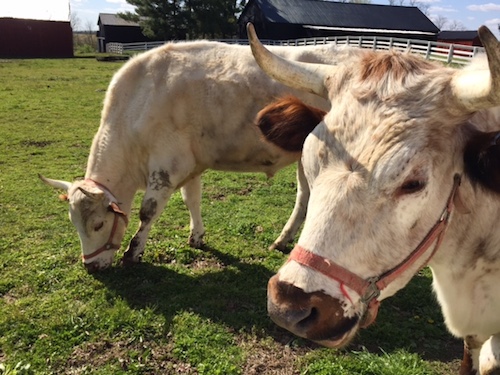
I headed straight to the "backdoor garden," which although somewhat untended at this time of year, had a nice assortment of plants. Some of them were ones I had not seen before, harkening back to an earlier time.
Here's a brief description of what I saw (I won't bother with pictures of most of the plants since very few looked like much of anything at this time of year!):
Calendula officinalis, or pot marigold, has been used both as a medicinal plant* and also as a companion plant, the latter because of its tendency to attract hoverflies. (Hoverflies are used as a natural pest control for aphids.)
Calendula has been used for centuries in a number of ways:
The bright yellow blossom of this herb was used to make a dye to color cheese and butter. In the kitchen, leaves and florets were added to sauces, soups, porridge, and puddings for color and medicinal benefit. The dried, powdered blossoms have also been used as a substitute for saffron in cooking. During the Civil War, calendula was used to stop the blood flow from battle wounds. Calendula blossom preparations continue to be valued as an antiseptic for external application to scrapes, burns, cuts, or wounds. Local application, in the form of a plant poultice or an infusion soaked in a cloth and applied to a wound, is an effective healing remedy. The Romans valued the herb for its ability to break fevers. During the Middle Ages, calendula used for protection against the plague. In early American Shaker medicine, calendula was a treatment for gangrene.In addition to its first aid uses, calendula also acts as a digestive remedy. An infusion or tincture of the flowers, taken internally, is beneficial in the treatment of ulcers, stomach cramps, colitis, herpes viruses, yeast infections, and diarrhea. An infusion may also be used as an external wash helpful in treating bee stings, eye inflammations, boils and abscesses, varicose veins, eczema, acne, and as a gargle for mouth sores or a rinse to relieve toothache.
Calendula should not be confused with French or Mexican marigold, both from the genus Tagetes.
Calendula is easy to grow. And behaves as either a short-lived perennial or a self-seeding annual, depending on local conditions.
Yarrow, aka "Milfoil" from the genus Achillea, was used by the Shakers to staunch bleeding, as well as for seasoning. It's a hardy perennial.
Elecamp (or Elecampane) is a large perennial with a myriad of uses. A bit about it here:
Elecampane is named after Helen of Troy. As the legend goes, she was holding elecampane in her hand when she left to live with Paris in Troy, another legend says that it sprung up from where her tears fell. It was used in ancient Rome for culinary purposes as well as medication. Elecampane is native to Europe and parts of Asia, but it is cultivated all over the world. Research has shown that elecampane contains insulin that can provide bronchial relief. It can also stimulate the immune system. It was once used in the treatment of tuberculosis infections.
Horehound is a member of the mint family, with many of mint's characteristics, including a tendency toward being invasive. (You might have heard of it when you were at an old-fashioned candy store.) It's one of the few plants that were already flowering when I visited the Shaker Village a few weeks ago. Being a fan of mint, I naturally crushed some leaves to check out its aroma.
Ugh. It wasn't a very pleasant smell. If I was a member of The Tribe, I might've known better:
The name may suggest a breed of gray dog, but that's misleading. "Hore-" does mean hoary (gray or white in Old English), but "-hound" is not canine; it's simply an old name for the herb. The generic name Marrubium is the name by which the Romans knew the herb, and vulgare means common. Other opinions are that Marrubium refers to "an ancient town of Italy" or to a Hebrew word for bitter. Some references list horehound among the bitter herbs Jews eat at Passover, but according to Jo Ann Gardner ("Bitter Herbs: A New Look at the Plants of the Bible," The Herb Companion, April/May 1990), it is not among the original bitter herbs of the Bible.Several other herbs of the mint family also are called horehound, resembling Marrubium in that their flowers are clustered in the leaf axils. Water horehounds belong to the genus Lycopus, and black (stinking) horehound and Greek horehound to the genus Ballota.
According to this source, you should be cautious in your consumption of this herb.
**UPDATE:
Polliwog the 'Ette points out this is not horehound, but is more likely to be catmint:
Catmint has a very strong and fairly unique scent when crushed like what you described as well. I've always had a "thing" for it because my first encounter with it was in elementary school shortly after reading a fairytale about a boy turned into a dwarf who was rescued by smelling an oddly scented herb. Can't get much more oddly scented than catmint.
Although Black horehound has purple flowers, catmint seems to possess more of the characteristics of the plant I saw.**
Mountain Mint, or Pycnanthemum muticum, is a species of mint that is particularly valued for butterfly gardens. It did smell good. (I checked.) Some people grow it as an insect repellant.
Silver Wormwood, also known as Prairie Wormwood or Silver Mugwort, is a member of the genus Artemesia:
Important in medicine, in cooking, and as landscape plants, the artemisias are richly deserving of the honour. They include tarragon, one of the finest and most important ingredients in French cuisine, sweet annie, the source of a medicine crucially important for the prevention and treatment of malaria, and wormwood, the defining ingredient of vermouth, without which the martini could not exist.Man's connection to artemisia goes back a long way. They are found growing in large expanses throughout the world and surely would have caught the eyes of early hunters and gatherers. According to the Greek myths, Artemis, the goddess of the wilderness and of the hunt, gave the power of the plant to Chiron the Centaur who was a great healer and teacher. It was Chiron who then developed the first medicines from artemisia.
Soapwort, or Saponaria officinalis, can be used to make soap. Although that last link says that soapwort prefers enriched soils, the Missouri Botanical Garden suggests otherwise. The flowers look quite pretty.
Costmary, or Tanacetum balsamita, is a plant with many uses:
Native to the eastern Mediterranean, Costmary was introduced into England in the 16th century and very quickly became extremely popular. With a multitude of uses it appeared in all gardens and was once considered to be one of the most common of garden plants.Costmary is an incredibly useful perennial herb. Its leaves have a eucalyptus-like aroma which has been described as like garden mint with hints of balsam. The long, broad and resinous leaves support loose clusters of tiny, daisy-like flowers that emit a pleasant, balsamic fragrance.
Costmary was used for many purposes, culinary, medicinal aromatherapy or ornamental. It was known as Alecost, used to clear, flavour and aid in the preservation of beer and ales before being superseded by hops. Today it is usually used in the kitchen as a salad green or potherb. The leaves or stems or flowers can be cooked and used for food or seasoning, preparing tea or adding essence.
Some advice on how to grow it here.
Apothecary Rose is believed to have originated in ancient Persia. Valued for centuries because of its beauty, the Shakers used them to produce rose water (and probably for other things, such as making jellies from the rose hips). I love rose water in Indian food, myself.
Orris Root is derived from Irises:
From ancient times the stately Iris stood as a symbol of power and majesty - it was dedicated to Juno and was the origin of thesceptre, the Egyptians placing it on the brow of the Sphinx and on the sceptre of their kings, the three leaves of its blossoms typifying faith, wisdom and valour.Cultivation has produced a great number of varieties, both among the bulbous or Spanish Iris (Iris xiphium) and the herbaceous, or Flag Irises, which have fleshy, creeping rootstocks or rhizomes. Among the latter, many have a considerable reputation for their medicinal virtues; in all the species belonging to this genus, the roots being more or less acrid, are possessed of cathartic and emetic properties. The chief economic use of the Iris at the present time is for the production of Orris Root (Rhizoma Iridis), which is derived from I. Germanica, I. pallida, and I. Florentina, collected indiscriminately in Italy from these three species, well-known and very beautiful ornamental plants, natives of the eastern Mediterranean region, extending into Northern India and Northern Africa, and largely cultivated for their rhizomes in Southern Europe, mostly on the mountain slopes.
More about Orris Root and irises here.
If these Olde Timey plants appealed to you, this link describing the (now defunct) Herb Garden at Norcross Wildlife Sanctuary might also be of interest. It provides a nice overview of five types of herb beds: culinary, dye, fragrance, household, and medicinal.
I found this post at Old Sturbridge Village that provides a brief description of how some of these herbs were used to be interesting, as well:
Most of Mrs. Child's advice about herbs was related to their medicinal uses, especially soothing teas for indigestion and headaches. Her book was dedicated to economy, so she recommended growing one's own herbs. "Those who have a little patch of ground will do well to raise the most important herbs; and those who have not will do well to get them in quantities from some friend in the country." It was not economical to buy from apothecaries who made money by selling herbs!"Herb tea, to do any good, should be made very strong," she wrote. For digestive disorders, she recommended several herbs -- summer savory, pennyroyal, tansy, thoroughwort, succory and elderflowers. For "inveterate coughs" a tea of coltsfoot and flaxseed sweetened with honey was recommended, while "an almost certain cure for a cough" was a blend of lungwort, maidenhair, hyssop, elecampane and horehound steeped together. For a fever, a tea of sweet balm or catnip was recommended.
Yum!
For a more modern take on the medicinal properties of these and other herbs, check out this blog.
That's a short report from my visit. The village also has a grove of apple trees including many older varieties that I had never seen before. There were also indoor exhibits showing how they prepared and stored what they grew (and raised), as well as a working farm. It was a good opportunity to reflect on how intentionally the Shakers lived. There's much to admire about that, although I am glad that I don't have to be as accomplished in the garden as they were!
This is the closest I come to living like a Shaker:
Where do you go for gardening inspiration?
Now, without further ado, heeeere's KT:
Hello, Horde. I will be away from the intertubes until later today, but I thought I would give you an update on my one off-season crop this spring:
Baby Broccoli
A while back, I saw among the last of the 6-packs of cool-season veggies at Walmart some "baby broccoli". I decided to try a pack even though I expected that the weather could be warm, or even hot, before harvest time. What the heck. I had a couple of big pots that needed something new in them. I figured that even if it bolted, I could eat the flowers.
I had never seen the cultivar name "Artwork", but the tag said resists bolting in warm weather. Turns out that this cultivar is a 2015 AAS winner. The directions called for picking the central heads when they were an inch across, or maybe an inch and a half. I tried some raw. I am not a big fan of raw broccoli, unless marinated, and this veggie was pretty close to raw broccoli in flavor.
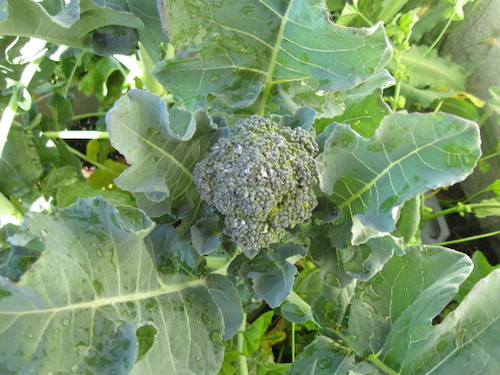
You may have encountered "baby broccoli" as "Broccolini". In case you have never tried it, this relatively new vegetable is a hybrid between broccoli and Chinese kale (kai-lan). It has small broccoli-like heads and long-ish, tender stems. It looks sort of like Sprouting Broccoli or like the lusty-flavored Rapini (Broccoli Raab). It is sweet and mild, with suggestions of asparagus, according to some. Here are the side shoots of "Artwork" that I picked about three weeks after harvesting the central heads:
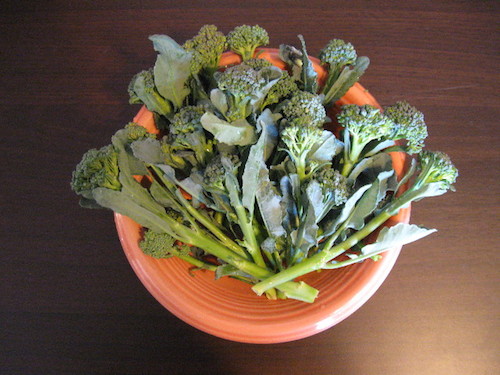
As Broccolini gained popularity in fine grocery stores, gardeners started to look for seeds. But the commercial trademark holders had the market cornered.
Sanbon Incorporated originated a commercial program for "asparation" (its registered trademark) in Mexico in 1994 and took it to the US market in 1996; Mann's took it to the US market in 1998 under its trademarked name, Broccolini®. It is grown near the central California coast during the spring, summer, and fall seasons and Yuma, Arizona throughout the winter.
It was interesting to watch the quest in the Gardenweb forums to identify this veggie and obtain seed. A few determined American gardeners went to the expense of ordering seed from commercial wholesale sources overseas. Now, several similar cultivars are available. Johnny's calls Happy Rich the best-tasting selection. I think they bred it. Apollo and Atlantis were among the first widely available hybrids. Burpee featured Apollo in its catalog a while ago, and although it is still on the website, it has been replaced by a unique cutting broccoli"> called "Royal Tenderette" in the catalog. I am not sure if this indicates low popularity for Apollo or just Burpee's quest for novelty. If you try it, let me know how it performs for you.
You can now get seed for Sakata's original commercial Baby Broccoli cultivar Aspabroc. (Asparagus/Broccoli - get it?) "Available as seed to home gardeners for the first time! Known as Broccolini(R) in the produce section of your grocery store and on restaurant menus . . " I see that Pinetree is carrying it. Ditto Twilley, aimed at market growers in the Southeast.
Here is my Baby Broccoli sauteed with some chicken sausage (with apple) and a little carrot. I added some red pepper because the sausage was kinda sweet. Nice combo. Some of the lower stems of the Baby Broccoli were not as tender as I had hoped they would be, but we had some hot weather. I snapped the stems and peeled the lower sections. I liked the flavor even though the side-shoots grew in less-than optimal weather. Broccoli Raab or even Sprouting Broccoli would have been very intensely flavored under these conditions.
Next time, I will plant Baby Broccoli the fall. Hope you get to try a new garden veggie soon.
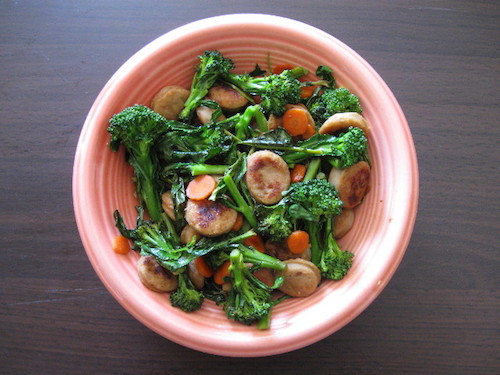
I will probably not be around when the thread goes up, so here are a couple of observations on the plants Y-not saw emerging in the Shaker garden:
I have tasted horehound candy. I remember its nasty flavor better than I remember the history lesson that went with it. Maybe if you had a really, really sore throat it would be more appealing.
Y-not's historical links are especially fine this week. I recommend the one on the Apothecary Rose, in particular, to history buffs.
I have grown some of the plants she mentioned above, or at least their close relatives. Though not in the setting of an herb garden. Maybe I can add a few nitty-gritty details next week. Just gritty in the case of Soapwort.
Y-not: Thanks, KT!
To wrap things up, how about a brief update on the nature preserve at Casa Y-not?
The house finches fledged. I even manage to catch a picture of one of them on his (or her) first flight:
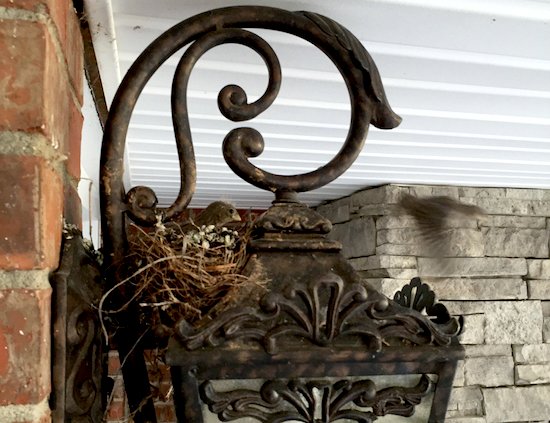
I've seen a male finch visiting the now empty nest. No sign of a second brood yet.
Mama Duck continues to tend the nest of eggs she laid under our boxwood bush:
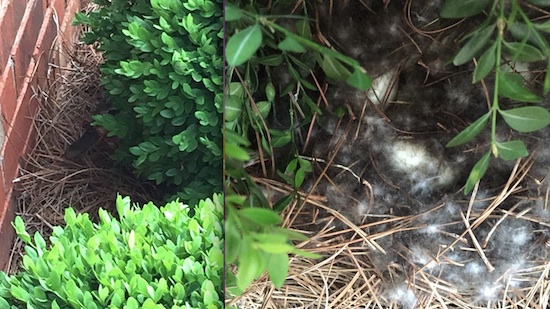
Now that she's finished laying eggs, she stays on the nest most of the time, leaving briefly in the early morning and late afternoons or early evenings. I've spotted Mama (and sometimes Papa) duck returning to our yard most mornings. It's a pleasant ritual.
And it also gives Bailey a chance to work on her herding skills!

What's happening in YOUR gardens this week?
*Please note: Although the plants I described today were all part of a Shaker herb garden and ostensibly safe for human use, please do your research before using any of these plants, particularly before eating them.
BeckoningChasm: "Hello Horde. Love the heck out of you all. Watch ..."
Braenyard - some Absent Friends are more equal than others _ : "WD, good to see you but glorifying physical adulte ..."
Robert, The Love Walrus: "This is a bold ONT. ..."
Robert, The Love Walrus: "Evening. So in hometown news there was an offic ..."
Robert, The Love Walrus: "Evening. So in hometown news there was an offic ..."
COMountainMarie : "And I'm never first...oh well.. ..."
Rev. Wishbone: "Yes but the real question is, was Die Hard a Star ..."
Blonde Morticia: " I really was first. ..."
clarence: "berry, berry bold. ..."
San Franpsycho: "Good evening morons e grazie wd ..."
Blonde Morticia: "e5vhbe5he5be ..."
'Twas the Day After Christmas Cafe
Roundabout Open Thread
Tree Mansion Open Thread
Hedgehog Hospital Open Thread
Jetpack Transfer Open Thread
The Most Played Movies on HBO During the 80s Open Thread
Skiing Mount Everest Open Thread
THE MORNING RANT: We Should Cheer for Bari Weiss to Fail in Her Effort to Rehabilitate CBS’ Reputation
Mid-Morning Art Thread
Paul Anka Haiku Contest Announcement
Integrity SAT's: Entrance Exam for Paul Anka's Band
AllahPundit's Paul Anka 45's Collection
AnkaPundit: Paul Anka Takes Over the Site for a Weekend (Continues through to Monday's postings)
George Bush Slices Don Rumsfeld Like an F*ckin' Hammer
Democratic Forays into Erotica
New Shows On Gore's DNC/MTV Network
Nicknames for Potatoes, By People Who Really Hate Potatoes
Star Wars Euphemisms for Self-Abuse
Signs You're at an Iraqi "Wedding Party"
Signs Your Clown Has Gone Bad
Signs That You, Geroge Michael, Should Probably Just Give It Up
Signs of Hip-Hop Influence on John Kerry
NYT Headlines Spinning Bush's Jobs Boom
Things People Are More Likely to Say Than "Did You Hear What Al Franken Said Yesterday?"
Signs that Paul Krugman Has Lost His Frickin' Mind
All-Time Best NBA Players, According to Senator Robert Byrd
Other Bad Things About the Jews, According to the Koran
Signs That David Letterman Just Doesn't Care Anymore
Examples of Bob Kerrey's Insufferable Racial Jackassery
Signs Andy Rooney Is Going Senile
Other Judgments Dick Clarke Made About Condi Rice Based on Her Appearance
Collective Names for Groups of People
John Kerry's Other Vietnam Super-Pets
Cool Things About the XM8 Assault Rifle
Media-Approved Facts About the Democrat Spy
Changes to Make Christianity More "Inclusive"
Secret John Kerry Senatorial Accomplishments
John Edwards Campaign Excuses
John Kerry Pick-Up Lines
Changes Liberal Senator George Michell Will Make at Disney
Torments in Dog-Hell
The Ace of Spades HQ Sex-for-Money Skankathon
A D&D Guide to the Democratic Candidates
Margaret Cho: Just Not Funny
More Margaret Cho Abuse
Margaret Cho: Still Not Funny
Iraqi Prisoner Claims He Was Raped... By Woman
Wonkette Announces "Morning Zoo" Format
John Kerry's "Plan" Causes Surrender of Moqtada al-Sadr's Militia
World Muslim Leaders Apologize for Nick Berg's Beheading
Michael Moore Goes on Lunchtime Manhattan Death-Spree
Milestone: Oliver Willis Posts 400th "Fake News Article" Referencing Britney Spears
Liberal Economists Rue a "New Decade of Greed"
Artificial Insouciance: Maureen Dowd's Word Processor Revolts Against Her Numbing Imbecility
Intelligence Officials Eye Blogs for Tips
They Done Found Us Out, Cletus: Intrepid Internet Detective Figures Out Our Master Plan
Shock: Josh Marshall Almost Mentions Sarin Discovery in Iraq
Leather-Clad Biker Freaks Terrorize Australian Town
When Clinton Was President, Torture Was Cool
What Wonkette Means When She Explains What Tina Brown Means
Wonkette's Stand-Up Act
Wankette HQ Gay-Rumors Du Jour
Here's What's Bugging Me: Goose and Slider
My Own Micah Wright Style Confession of Dishonesty
Outraged "Conservatives" React to the FMA
An On-Line Impression of Dennis Miller Having Sex with a Kodiak Bear
The Story the Rightwing Media Refuses to Report!
Our Lunch with David "Glengarry Glen Ross" Mamet
The House of Love: Paul Krugman
A Michael Moore Mystery (TM)
The Dowd-O-Matic!
Liberal Consistency and Other Myths
Kepler's Laws of Liberal Media Bias
John Kerry-- The Splunge! Candidate
"Divisive" Politics & "Attacks on Patriotism" (very long)
The Donkey ("The Raven" parody)

